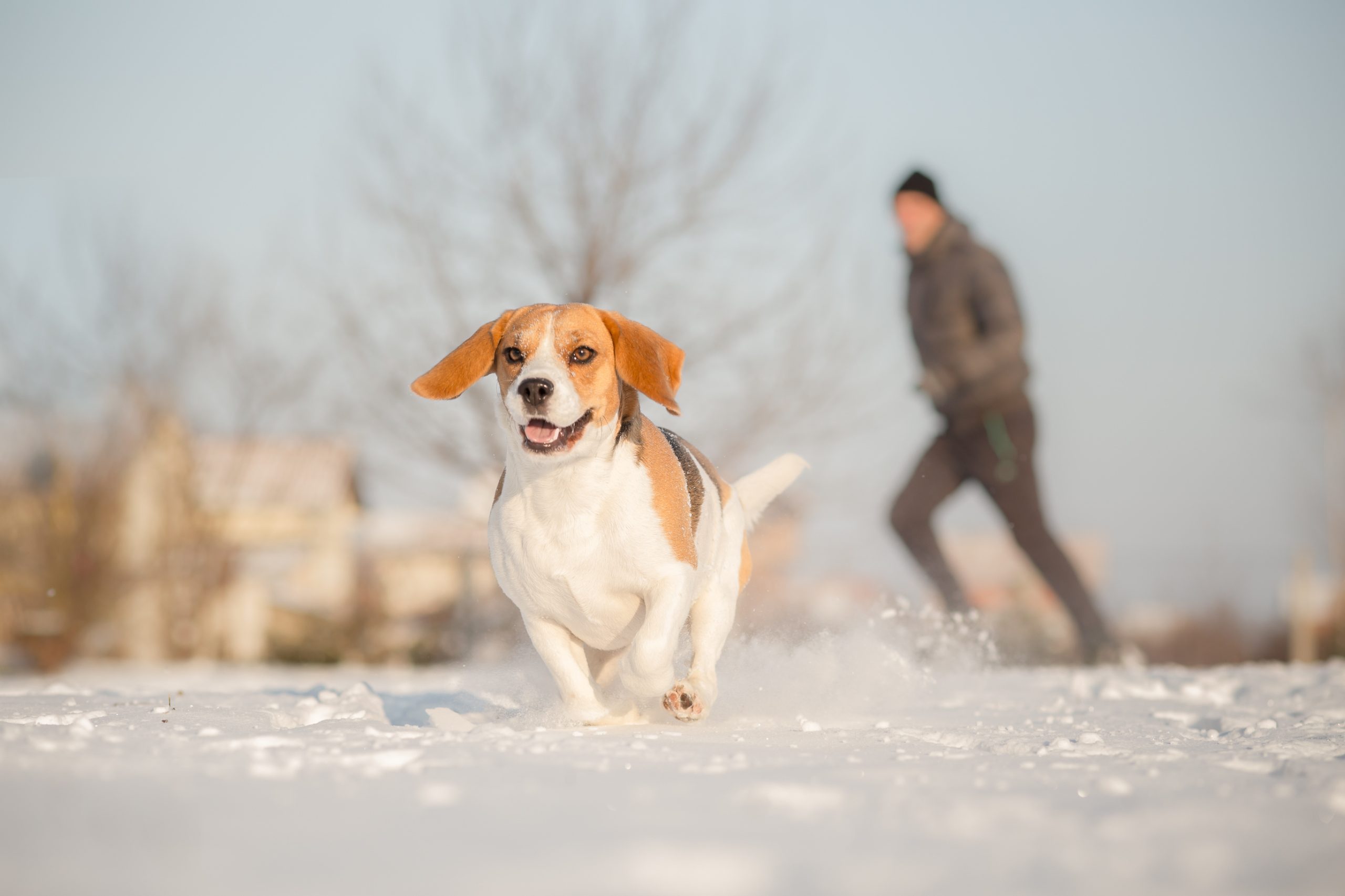

Winter has arrived, and while we’re cozy under blankets and sipping warm drinks, our dogs feel the chill too. Winter isn’t just about keeping them warm, it’s about giving them the right nutrition to stay healthy and energetic all season long.
If you’re a pet parent wondering how to support your dog during colder months, here’s what you need to know.
Why Winter Nutrition Matters
Cold weather means your dog uses more energy to stay warm. Without proper nutrition, they can experience fatigue, a dull coat, or lowered immunity. A balanced diet tailored for winter helps keep them strong, active, and happy.
Essential Food Categories for Winter Wellness
- Protein-Packed Meals
Protein is the foundation of your dog’s health. It supports muscle strength and energy—especially important when temperatures drop. Look for high-quality kibble or wet food featuring real meat like chicken, fish, or lamb.
Tip: Check labels for “high-protein” formulas to meet seasonal energy needs.
- Healthy Fats for Warmth
Fats provide concentrated energy and help maintain a shiny coat. Omega-3 and Omega-6 fatty acids are key for skin health and warmth. Fish oil or flaxseed are great additions, and many premium foods include these naturally.
Pro Tip: Balance is important, too much fat can lead to weight gain.
- Fibre for Digestive Health
Seasonal changes can affect digestion. Fibre from carrots, pumpkin, or sweet potatoes keeps your dog’s gut healthy and helps them feel full. Many complete diets include fibre-rich ingredients for convenience. - Vitamins & Minerals for Immunity
Winter can challenge your dog’s immune system. Nutrients like Vitamin C, Vitamin D, and zinc help fight seasonal stress. Choose foods fortified with essential vitamins and minerals to keep their defences strong. - Hydration-Friendly Options
Dogs often drink less water in winter. Wet food or pet-safe broths can help maintain hydration. Serving warm broth over kibble is a comforting way to boost fluid intake.
Extra Tips for Winter Care
- Adjust Portions: If your dog is less active, reduce food slightly to avoid weight gain.
- Serve Warm Meals: A little warmth makes mealtime more inviting.
- Keep Them Cozy: Blankets, coats, and indoor play keep your dog comfortable and happy.
The Bottom Line
Winter doesn’t have to slow your dog down. By focusing on protein, healthy fats, fibre, vitamins, and hydration, you’ll help them thrive through the season. Explore Feeds’n Needs’ selection of premium pet foods and winter care essentials—because a healthy dog is a happy dog.
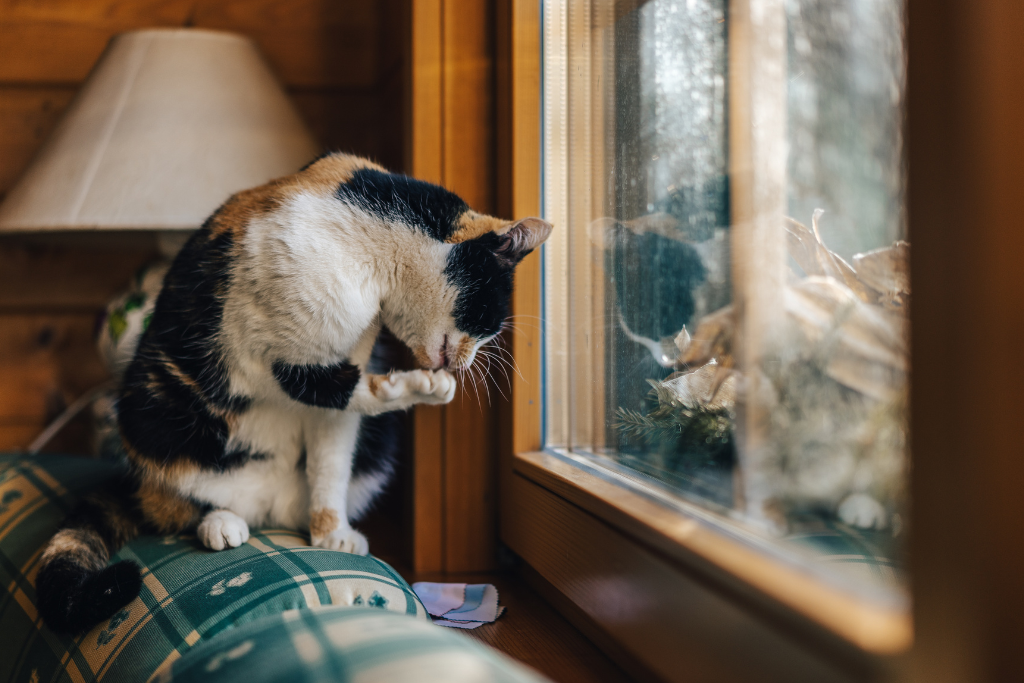

Prevent Cabin Fever in Pets During Long Winters
Short daylight, icy sidewalks, and stormy stretches can reduce outdoor time. Enrichment keeps pets mentally engaged, reduces anxiety, and prevents boredom behaviors (chewing, vocalizing, scratching).
Dogs: Indoor Activities
- Puzzle Feeders: Slow feeding, boost problem-solving.
- Scent Games: Hide treats in boxes or towels and let them “hunt.”
- Training Bursts: 10-minute sessions to learn new cues and tricks.
- Indoor Agility: Use cones, chairs, and blanket tunnels for obstacle fun.
- Tug & Fetch: In hallways or basements and mind slippery floors.
Cats: Indoor Activities
- Vertical Spaces: Add shelves or cat trees for climbing.
- Hunt & Pounce: Wand toys, laser pointers (end with a real catch like treats).
- Foraging Feeders: Scatter kibble in snuffle mats or puzzle toys.
- Window Watching: Place bird-friendly feeders outside windows for safe viewing.
Routine & Environment
- Maintain a consistent routine: meals, play, rest.
- Use cozy beds away from drafts.
- Add background nature sounds for calming ambience.
Maritime-Friendly Tips
- After storm closures, plan micro-walks when sidewalks are cleared.
- Choose grippy booties for dogs to prevent slips.
- Keep salt off paws: wipe after outdoor exposure; use pet-safe de-icers.
Explore puzzle toys, snuffle mats, interactive feeders, booties, and pet-safe de-icers at Feeds’n Needs – your local partner for winter pet wellness.
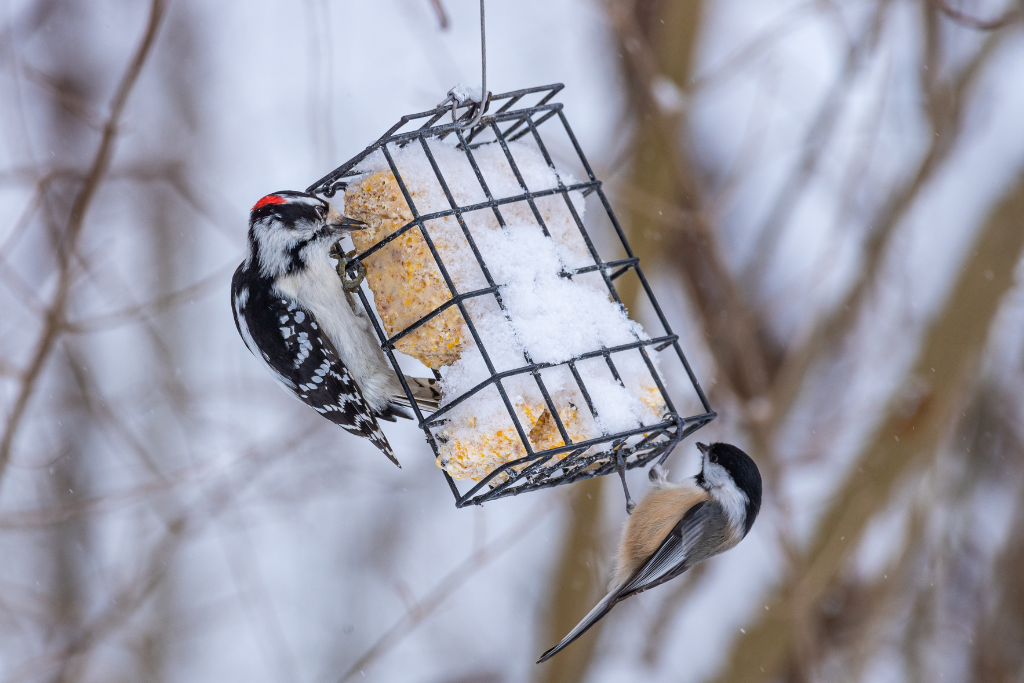

Winter Bird Feeding Myths Debunked
Why Myth-Busting Matters
In the Maritimes, winter can mean freeze-thaw cycles, coastal winds, nor’easters, and icy conditions which make natural food scarce for birds. Responsible feeding helps local species like Black-capped Chickadees, Blue Jays, Red-breasted Nuthatches, and Downy Woodpeckers stay healthy through the season.
Myth #1: “Feeding Birds Makes Them Dependent”
- Fact: Birds are opportunistic. They balance natural food sources (seeds, berries, insects) with feeders. Your feeder is supplemental, especially during storms or deep freezes.
- Your Action: Keep feeders consistent but don’t worry if you miss a day because birds will continue to forage widely.
Myth #2: “Feeding Disrupts Migration”
- Fact: Most overwintering species in the Maritimes aren’t migrating. For migrants, daylight and genetics drive migration, not feeders.
- Your Action: Offer high-energy foods (black oil sunflower, suet) to sustain overwintering birds during cold snaps.
Myth #3: “Bread Is Fine for Birds”
- Fact: Bread lacks nutrients and can harm birds. Choose quality seeds and suet instead.
- Your Action: Stock black oil sunflower, peanut pieces, Nyjer (for finches), and suet with nuts or insects.
Myth #4: “Birds Don’t Need Water in Winter”
- Fact: Birds need clean, unfrozen water for drinking and feather care.
- Your Action: Add a heated bird bath or place warm water in shallow dishes and refresh as needed.
Myth #5: “Cleaning Feeders Isn’t Necessary”
- Fact: Dirty feeders can spread disease. Winter cleaning is as important as summer.
- Your Action: Clean feeders every 1–2 weeks with a 9:1 water-to-bleach solution and rinse thoroughly.
Other Tips
- Shelter from wind: Place feeders near spruce or cedar hedges to reduce exposure.
- Snow management: Clear perches and trays after snowfall.
- Storm prep: Top up feeders before nor’easters; switch to suet cages and hopper feeders that shield seed.
Support local birds this winter. Shop wild bird feed, suet, and heated bird baths at Feeds’n Needs across the Maritimes.
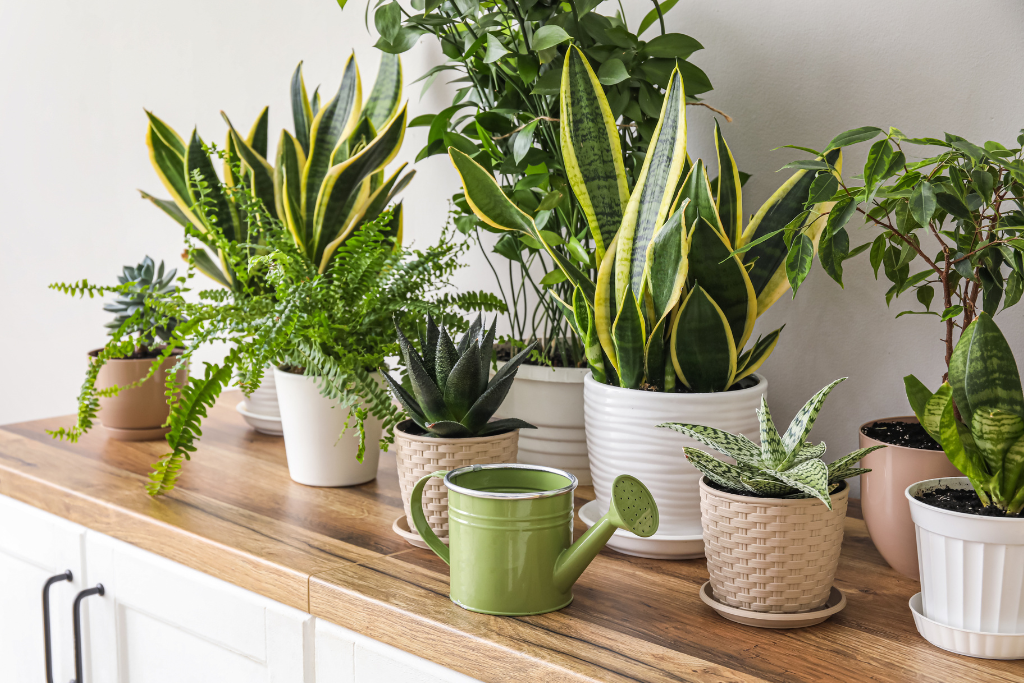

Keep Indoor Plants Thriving In Winter
Winter Challenges in Maritime Homes
Dry indoor air from baseboard or wood heat, short daylight, and drafts from coastal winds can stress plants. These simple habits keep your indoor green friends thriving.
1) Light: Make Every Ray Count
- Move plants to south or east-facing windows for maximum winter light.
- Rotate weekly for even growth.
- Use LED grow lights for low-light species or rooms with limited sun.
2) Humidity: Combat Dry Air
- Group plants together to create a microclimate.
- Place pots on pebble trays with water (not touching the pot base).
- Avoid misting near windows during freeze-thaw, it can lead to fungal spots.
- Consider a small humidifier for tropical plants like monstera or ferns.
3) Watering: Less Is More
- Test soil with your finger. Water only when the top inch is dry.
- Water thoroughly, then empty saucers to prevent root rot.
- Reduce watering frequency for succulents and cacti.
4) Temperature & Drafts
- Keep plants away from cold windows and heater vents.
- Ideal indoor temps: 18–24°C for most houseplants.
5) Feeding & Repotting
- Hold off on fertilizer until late February/March when growth resumes.
- Repot only if severely root-bound; otherwise wait for spring.
Maritime-Friendly Plants
- Snake Plant, ZZ Plant, Pothos (tolerate lower light).
- Spider Plant, Peace Lily (handle variable humidity).
- Herbs like rosemary and mint with supplemental light.
Find LED grow lights, humidity trays, potting mix, and plant care tools at Feeds’n Needs to keep your winter plant corner flourishing.
Conclusion
With proper care—dry bedding, good ventilation, and a few preventive measures—you can keep your flock safe and healthy all winter long. Here’s to happy hens and a frostbite-free season!
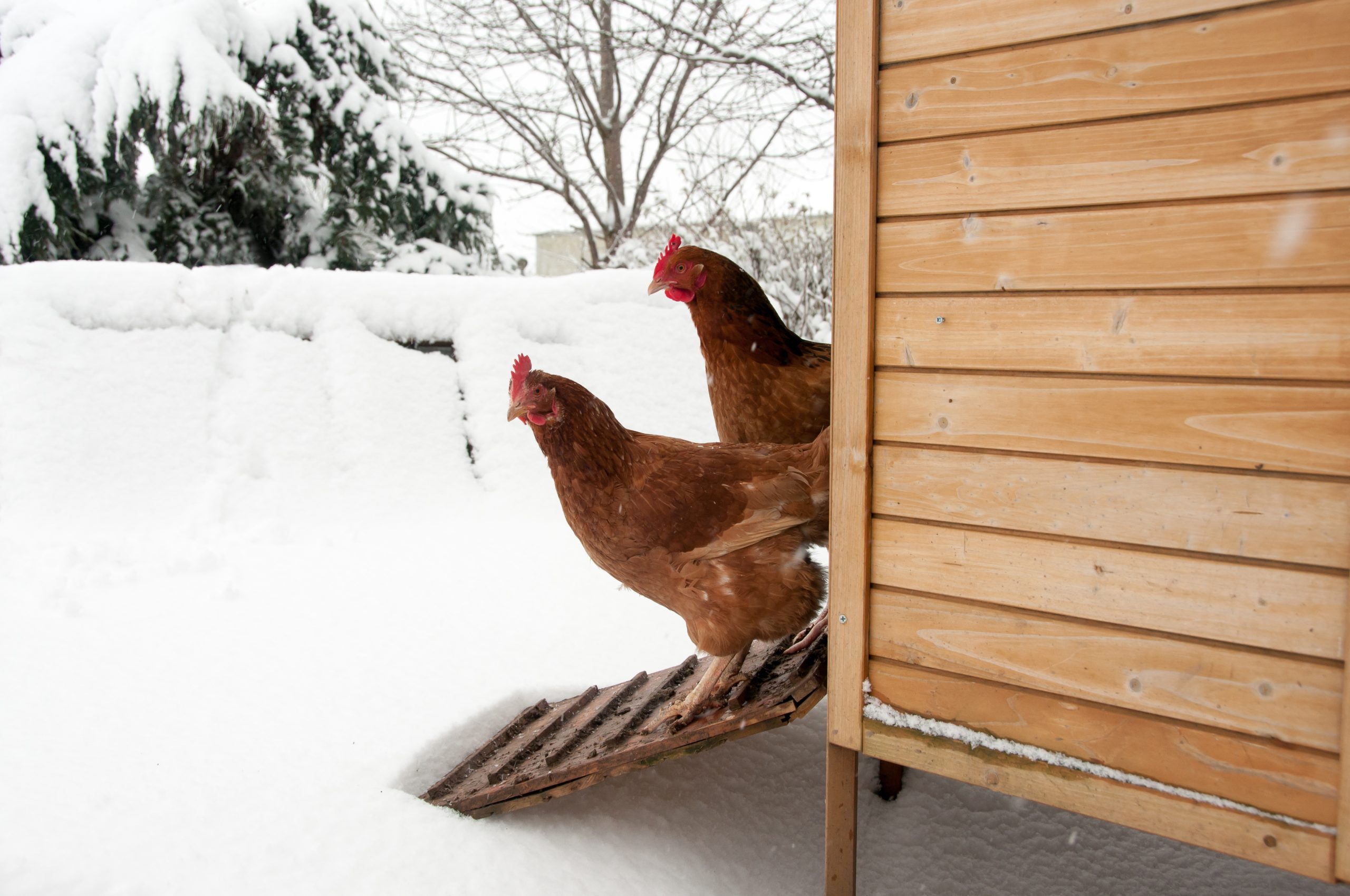

How to Prevent Frostbite in Chickens
Cold weather can be tough on backyard flocks, and frostbite is one of the most common winter challenges for chicken owners. Understanding what frostbite is, how to recognize it, and how to prevent it can make all the difference in keeping your birds healthy and comfortable.
What Is Frostbite in Chickens?
Frostbite occurs when skin and underlying tissues freeze, typically affecting a chicken’s comb, wattles, and sometimes feet. Because these areas have small surface areas, frostbite can set in quickly—especially during extreme cold or wind chills. Early detection and treatment are key to preventing long-term damage.
Signs of Frostbite
Watch for these symptoms:
- Early Stage: Combs and wattles turn gray; feet may appear dark red.
- Advanced Stage: Swelling in large combs and wattles, blackened tissue, or necrotic areas. Severe frostbite often cannot be reversed.
Chickens are good at hiding discomfort, so knowing their normal behavior helps you spot problems early.
What to Do If Frostbite Occurs
If you notice frostbite:
- Warm Slowly: Use a warm, damp cloth on combs and wattles for 15–20 minutes. For feet, a shallow lukewarm bath works well. Avoid rapid warming or rubbing the tissue.
- Isolate & Monitor: Place the bird in a warm, draft-free area with deep bedding. Apply a hydrogel spray to promote healing.
- Watch for Infection: Severe cases may involve blisters or tissue loss—contact a vet if needed.
What Temperature Puts Chickens at Risk?
When temps drop below 32°F (0°C)—especially with wind chill—frostbite becomes a real threat. Roosters and breeds with large combs are most vulnerable. Daily checks and proper shelter are essential.
7 Tips to Prevent Frostbite
- Apply a Protective Salve: Use coconut oil or bag balm on combs and wattles (avoid Vaseline in extreme cold—it can freeze).
- Ensure Proper Ventilation: Good airflow prevents moisture buildup, reducing frostbite risk.
- Provide Electrolytes & Vitamins: These can help birds cope with cold stress.
- Create Ample Roosting Space: Chickens huddle for warmth—make sure everyone has room.
- Avoid Open Water Bowls: Use nipple waterers to prevent wet feathers and feet.
- Keep Bedding Dry: Damp bedding increases frostbite risk. Use deep litter and refresh often.
- Add a Safe Heat Source: In extreme cold, consider a heating panel or caged lamp (avoid fire hazards).
Can Chickens Recover From Frostbite?
Recovery takes time—often 4–6 weeks. Dead tissue will slough off naturally, leaving healthy tissue behind. The biggest risk is infection, so monitor closely and consult a vet if needed.
Conclusion
With proper care—dry bedding, good ventilation, and a few preventive measures—you can keep your flock safe and healthy all winter long. Here’s to happy hens and a frostbite-free season!
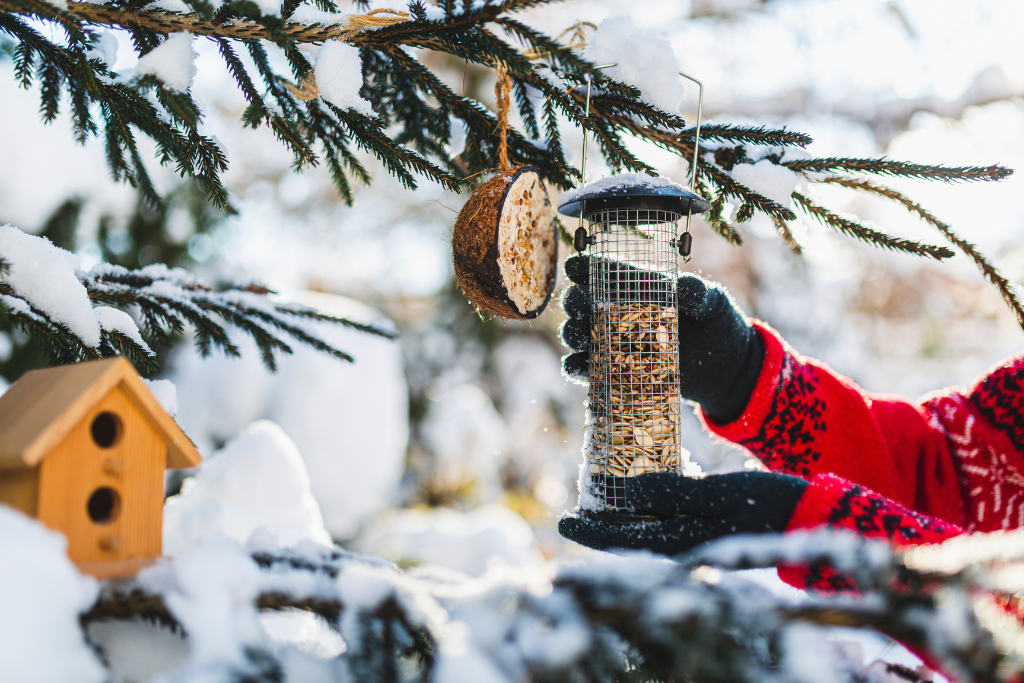

Prepare Birds for Winter
As winter settles in, the vibrant colors of Blue Jays, Red-Breasted Nuthatches, and Northern Cardinals bring life to an otherwise dull landscape. But with snow covering natural food sources and insects disappearing, birds face a tough challenge finding enough to eat. By providing food, water, and shelter, you can help your feathered friends survive—and even thrive—through the cold months.
Why Feed Birds in Winter?
Winter is one of the most energetically demanding seasons for birds. They need extra calories to maintain body heat, yet natural seeds and insects become scarce. Feeding birds not only helps them endure harsh conditions but also brings beauty and activity to your backyard. Keeping feeders up into spring can even support migrating species on their long journeys north.
Top Tips for Winter Bird Feeding
- Choose the Right Feeders
- Tube Feeders: Perfect for black oil sunflower, mixed seed, safflower, or peanuts. These attract chickadees, nuthatches, goldfinches, and finches.
- Hopper Feeders: Great for safflower, sunflower seeds, or cracked corn. They draw larger birds like cardinals, jays, and red-winged blackbirds.
- Suet Feeders: Suet is a high-energy food loved by woodpeckers, chickadees, and nuthatches.
Avoid placing seed directly on the ground—it attracts deer and other unwanted guests. Instead, opt for mess-free seed blends and consider fencing feeders to keep wildlife out.
- Provide Fresh Water
Water is just as critical as food. When natural sources freeze, birds struggle to stay hydrated. Use a sturdy birdbath in a sunny spot or invest in a heated birdbath to keep water accessible. Refresh water every other day and clean baths with a 9:1 water-to-vinegar solution.
- Keep Feeders Clean
Dirty feeders can spread disease. Clean them every two weeks with a solution of 9 parts water to 1 part bleach, scrub thoroughly, and dry before refilling.
- Offer High-Calorie Foods
Winter birds need quick energy. Stock feeders with:
- Sunflower seeds
- Peanuts
- Suet cakes
- Mealworms
- You can also offer fruits like apples, grapes, cherries, and oranges (asy-to-eat slices)
- Create Shelter
Brush piles and bird boxes provide safe roosting spots during storms. Nest boxes can double as winter shelters.
Extra Tips for Success
- Fill feeders daily, ideally in late afternoon, to give birds an energy boost before nightfall.
- Spread feeders around at different heights for safety and variety.
- Brush snow and ice off feeders after storms.
- Leave seed-bearing plants and leaf litter in your garden for natural food sources.
Helping birds through winter is rewarding—for them and for you. With a little effort, you’ll enjoy a lively backyard full of color and song all season long.
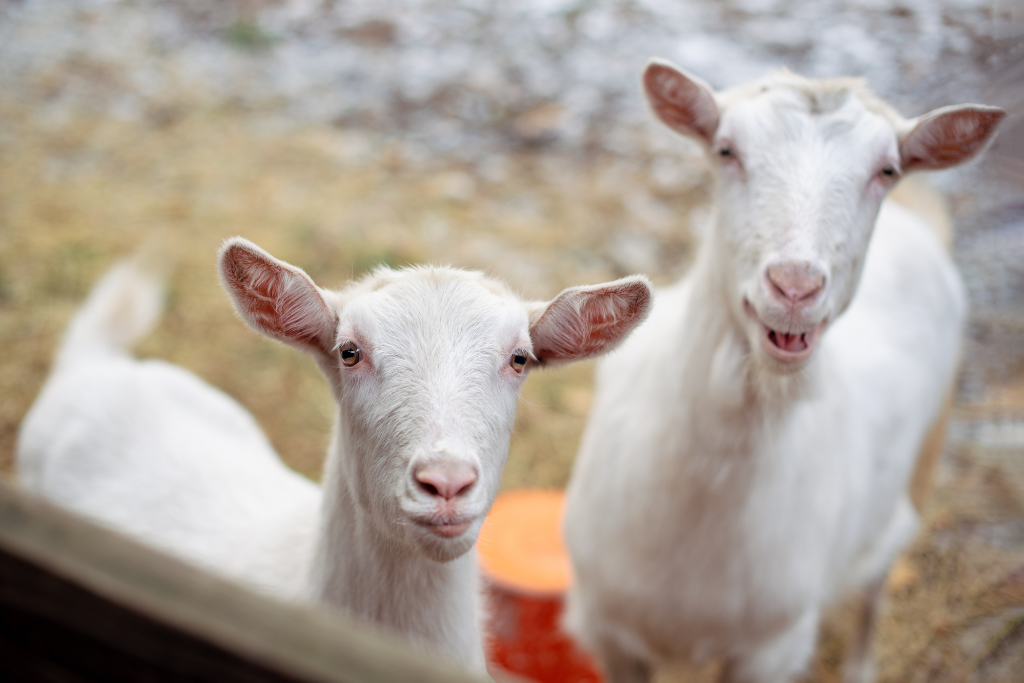

Winter Care for Goats
Ensuring the well-being of your goats is a top priority as winter weather approaches. Cold temperatures and harsh conditions bring unique challenges that can impact your goats’ health and comfort. By covering the basics—shelter, water, and nutrition—you can help your herd thrive all season long.
Shelter: Protection from the Elements
Goats don’t need elaborate housing, but they do require protection from wind, snow, and rain. At a minimum, provide a three-sided shelter that blocks cold north winds while still allowing ventilation. In barns, consider using a door flap to keep wind and snow out while letting goats move freely. To maintain comfort and insulation, keep plenty of clean, dry straw or shavings available for bedding.
Ventilation Matters:
Avoid sealing the barn too tightly. While drafts should be minimized, airflow is essential to prevent moisture buildup, which can lead to pneumonia and other respiratory issues. Proper ventilation reduces humidity and keeps your goats healthy.
Keep It Dry
Moisture is the enemy in winter.
- Location: Avoid low-lying areas where water collects.
- Maintenance: Regularly refresh bedding and keep loafing areas dry to prevent hoof problems like rot or scald, and udder issues such as mastitis.
Do Goats Need Heat?
Surprisingly, goats do not need supplemental heat in most cases. Heat lamps and jackets can interfere with their natural ability to acclimate. As temperatures drop, goats grow a thick winter coat for insulation.
Tip: If snow sits on their coat without melting, their insulation is working!
Typically only newborn kids or a sick goat require extra warmth—use heat lamps with extreme caution due to fire risk and cord chewing.
Water: Fresh and Unfrozen
Goats need constant access to fresh water, even more so in winter when hay replaces moisture-rich pasture. Without water, goats eat less and lose body condition. To prevent freezing, use heated water bowls or change water frequently.
Nutrition: Fuel for Warmth
Winter feeding isn’t just about calories—it’s about heat production.
- Hay is Key: Offer free-choice hay 24/7. Goats are ruminants, and the fermentation process in their rumen generates internal heat.
- Extra Energy: Consider adding alfalfa for protein and energy, but use caution with bucks and wethers to avoid urinary calculi.
- Minerals: Provide salt and mineral supplements year-round.
Helping Goats Adjust
Gradual acclimation is important. Keep goats outdoors as long as possible in fall so they develop thick coats before moving to winter housing. Goats generally handle snow well if they have dry shelter and clear paths to water and feeders. Plowed snow can even serve as a windbreak.


When to Switch from Kitten to Cat Food
As your kitten grows, their nutritional needs change. Knowing when and how to transition to adult cat food is essential for their health and development.
Can Kittens Eat Adult Cat Food?
The answer is on the label! If the food says, “for all life stages,” it’s formulated to meet the needs of both kittens and adult cats. Otherwise, stick with kitten food until it’s time to switch.
When to Switch
- Most Cats: Around 12 months old, when they’ve reached their full adult size.
- Large Breeds (like Maine Coons): Wait until 18 months to 2 years before transitioning.
How to Transition
Switching foods abruptly can cause digestive upset. Instead, make the change gradually over 7 to 10 days:
- Day 1–2: Mix 25% adult food with 75% kitten food.
- Day 3–4: Mix 50% adult food with 50% kitten food.
- Day 5–6: Mix 75% adult food with 25% kitten food.
- Day 7 and onward: Switch completely to the new adult cat food.
A slow transition ensures your cat’s digestive system adjusts comfortably, keeping them happy and healthy during this important change.


Fall Garden Prep
As the days grow shorter and the air turns crisp, it’s the perfect time to give your garden a little TLC before winter sets in. Prepping your garden in the fall not only keeps things tidy but also sets the stage for a healthy, vibrant growing season next year. Here’s how to wrap up the season with care:
Clean Up and Sanitize Your Garden
A tidy garden is a healthy garden. Start by removing any spent annuals and vegetable plants that have finished producing. This helps prevent pests and diseases from lingering through the winter.
- Toss diseased plants in the trash—not the compost pile—to avoid spreading pathogens.
- Leave healthy roots from nitrogen-fixing plants like beans and peas in the soil. They’ll break down naturally and enrich your garden.
- Weed thoroughly, especially those that have gone to seed, to reduce next spring’s weed load.
Enrich Your Soil
Fall is a great time to give your soil a boost so it’s ready to support new growth come spring.
- Test your soil every few years to check pH and nutrient levels. Fall is ideal for applying amendments like lime, which need time to take effect.
- Add compost—a 2–3 inch layer will feed your soil over the winter as it breaks down.
- Mulch generously with shredded leaves, straw, or wood chips to protect the soil and retain moisture.
Care for Perennials and Bulbs
Your perennials and bulbs need a little attention before the frost hits.
- Divide and transplant overcrowded perennials to give them room to thrive.
- Water deeply before the ground freezes to help roots stay hydrated through winter.
- Plant spring-blooming bulbs like tulips and daffodils now for a colorful show next year.
- Dig up tender bulbs such as dahlias and gladiolus and store them indoors.
Prep Your Tools and Equipment
Don’t forget to take care of your gardening gear!
- Clean and sharpen tools to keep them in good shape and ready for spring.
- Drain hoses and irrigation systems to prevent freezing and cracking.
- Store pots and containers in a dry place to avoid damage from freeze-thaw cycles.
Fall Planting and Final Harvest
There’s still time to enjoy a few more crops before winter.
- Plant garlic between September and the end of November.
- Harvest remaining produce before the first hard frost. Green tomatoes? Let them ripen on a sunny windowsill indoors.
With a little effort now, your garden will be healthier, your tools will last longer, and you’ll be one step ahead when spring rolls around. Happy fall gardening!
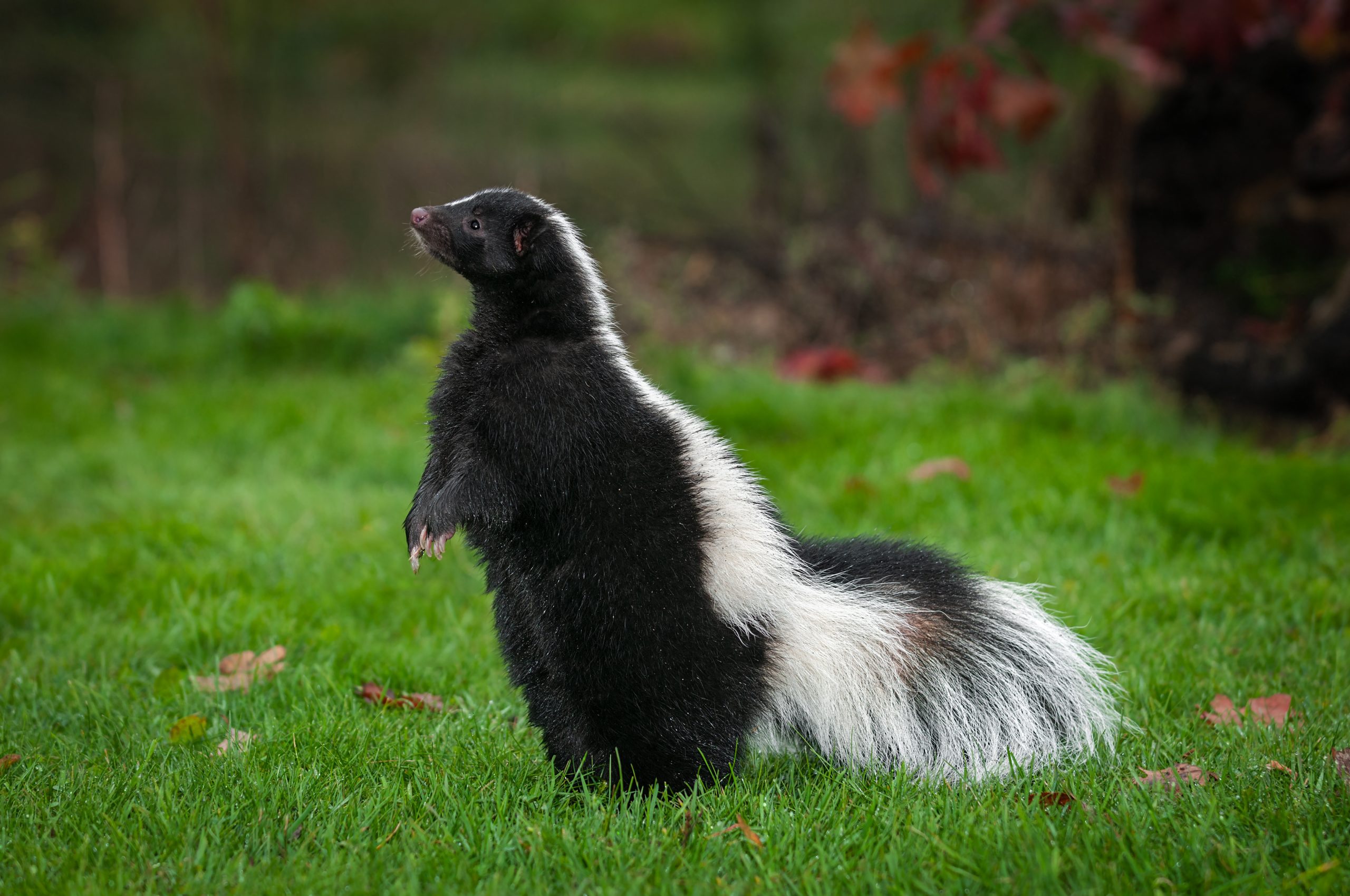

What to do When Your Dog Gets Skunked
It’s a scenario no pet owner wants to face: your dog comes bounding back from the yard, tail wagging… and smelling absolutely awful. Yep, they’ve been skunked.
Skunks are usually peaceful creatures, but when they feel threatened, they don’t hesitate to unleash their powerful defense mechanism — a foul-smelling spray that can linger for days. If your dog has had a run-in with one, here’s what you need to know to handle the situation calmly and effectively.
Ensure Your Dog is Okay
Skunk spray isn’t just smelly — it can cause physical discomfort and, in rare cases, health issues. Here are a few things to check right away:
- Eyes: If your dog was sprayed in the face, their eyes might be red or irritated. Flush them gently with clean water or pet-safe eye drops.
- Mouth: If the spray got into their mouth, rinse thoroughly with water to help remove the taste and odor.
- Wounds or Bites: Look for any signs of injury. If your dog was bitten, especially by a potential skunk with rabis, contact your vet immediately.
- Unusual Symptoms: Watch for signs like lethargy, pale gums, or dark-colored urine. These could indicate a rare reaction affecting red blood cells and should be checked by a vet.
Keep the Stink Outside
As tempting as it is to rush your dog indoors, resist the urge. Skunk odor can quickly spread through your home and cling to furniture, carpets, and clothing. Keep your dog outside while you assess the situation and prepare to clean them up.
How to Remove Skunk Smell from Your Dog
Feeds’n Needs carries products to help remove skunk smell, but you can also whip up a DIY solution that’s surprisingly effective. Here’s a tried-and-true homemade remedy:
Ingredients:
- 1 quart of 3% hydrogen peroxide
- ¼ cup baking soda
- 1 teaspoon liquid dish soap
Instructions:
- Mix the ingredients in a bowl (do not store — it can build pressure).
- Apply the mixture to your dog’s fur, avoiding the eyes and ears.
- Let it sit for a few minutes, then rinse thoroughly.
- Follow up with a full bath using pet shampoo and conditioner.
Note: This mixture may lighten dark fur temporarily and can damage fabrics, so use with care.
Alternative Option: Vinegar Rinse
If you don’t have hydrogen peroxide on hand, mix equal parts white vinegar and water. Apply and rinse as above.
If DIY isn’t your thing, Feeds’n Needs carries a range of skunk odor removal products, including:
- Skouts Honor® Skunk Odor Eliminator
- Nature’s Miracle Skunk Odor Remover Spray & Shampoo
- Loona Pet Atomizer
- De-Skunk Odor Destroying Shampoo
Availability may vary by location, so check with your local store.
Special Care for the Face
When treating your dog’s face, be extra cautious. Avoid getting any cleaning solution near their eyes, ears, or nose. Use a damp cloth to gently wipe the affected areas, and rinse with water if needed. If irritation persists, contact your vet.
Prevention Tips: Keep Skunks Away
The best way to deal with skunk spray? Avoid it altogether. Here are some tips to make your yard less inviting to skunks:
- Secure food sources: Store pet food and bird seed in sealed containers.
- Block hiding spots: Close off access to decks, sheds, and wood piles.
- Use deterrents: Motion-activated lights or sprinklers can scare skunks away.
- Discourage denning: Stuff suspected holes with leaves or paper, or sprinkle kitty litter nearby.
Conclusion
Getting skunked is never fun — for you or your dog. But with a little patience, the right cleaning method, and a watchful eye for any health concerns, your pup will be back to their usual self in no time. And next time they go sniffing around the yard, hopefully they’ll think twice before getting too close to a skunk.


